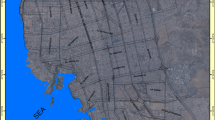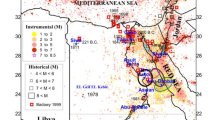Abstract
Seismic site characterization is the basic requirement for seismic microzonation and site response studies of an area. Site characterization helps to gauge the average dynamic properties of soil deposits and thus helps to evaluate the surface level response. This paper presents a seismic site characterization of Agartala city, the capital of Tripura state, in the northeast of India. Seismically, Agartala city is situated in the Bengal Basin zone which is classified as a highly active seismic zone, assigned by Indian seismic code BIS-1893, Indian Standard Criteria for Earthquake Resistant Design of Structures, Part-1 General Provisions and Buildings. According to the Bureau of Indian Standards, New Delhi (2002), it is the highest seismic level (zone-V) in the country. The city is very close to the Sylhet fault (Bangladesh) where two major earthquakes (M w > 7) have occurred in the past and affected severely this city and the whole of northeast India. In order to perform site response evaluation, a series of geophysical tests at 27 locations were conducted using the multichannel analysis of surface waves (MASW) technique, which is an advanced method for obtaining shear wave velocity (V s) profiles from in situ measurements. Similarly, standard penetration test (SPT-N) bore log data sets have been obtained from the Urban Development Department, Govt. of Tripura. In the collected data sets, out of 50 bore logs, 27 were selected which are close to the MASW test locations and used for further study. Both the data sets (V s profiles with depth and SPT-N bore log profiles) have been used to calculate the average shear wave velocity (V s30) and average SPT-N values for the upper 30 m depth of the subsurface soil profiles. These were used for site classification of the study area recommended by the National Earthquake Hazard Reduction Program (NEHRP) manual. The average V s30 and SPT-N classified the study area as seismic site class D and E categories, indicating that the city is susceptible to site effects and liquefaction. Further, the different data set combinations between V s and SPT-N (corrected and uncorrected) values have been used to develop site-specific correlation equations by statistical regression, as ‘V s’ is a function of SPT-N value (corrected and uncorrected), considered with or without depth. However, after considering the data set pairs, a probabilistic approach has also been presented to develop a correlation using a quantile–quantile (Q–Q) plot. A comparison has also been made with the well known published correlations (for all soils) available in the literature. The present correlations closely agree with the other equations, but, comparatively, the correlation of shear wave velocity with the variation of depth and uncorrected SPT-N values provides a more suitable predicting model. Also the Q–Q plot agrees with all the other equations. In the absence of in situ measurements, the present correlations could be used to measure V s profiles of the study area for site response studies.












Similar content being viewed by others
References
BIS 1893 (2002), Indian Standard Criteria for Earthquake Resistant Design of Structures, Part-1 General Provisions and Buildings. Bureau of Indian Standards, New Delhi.
Borcherdt, R.D. (1994), Estimates of Site Depending Response Spectra For Design (Methodology And Justifications). Earthquake Spectra. 10(4), 617–654.
BSSC (2001), NEHRP recommended provisions for seismic regulations for new buildings and other structures 2000 edition, part 1: Provisions, Report no. FEMA368, Building seismic safety council for the federal emergency management agency, Washington, D.C. USA.
Boore, D. M. and Joyner, W. B. (1997), Site amplification for generic rock sites, Bull. Soc. Am. 87, 327–41.
Dobry, R., Borcherdt, R.D., Crouse, C.B., Idriss, I.M., Joyner,W.B., Martin, G.R., Power,M.S., Rinne, E.E., Seed, R.B., (2000), Newsite coefficients and site classification system used in recent building seismic code provisions, Earthquake Spectra 16, 41–67.
Ganji, V., Gukunski, N., Maher, A., (1997), Detection of underground obstacles by SASW method numerical aspects, Journal of Geotechnical and Geoenvironmental Engineering 123(3), 212–219 ASCE.
IBC (2000), International Building Code-2000, 5th Edition. International Code Council: Inc., Falls Church, VA.
Idriss, I.M. (1990), Response of Soft Soil Sites During Earthquakes, Proceedings of the Memoria Symposium to Honor Professor Harry Bolton Seed, University of California, Berkeley.
IDRISS, I. M. (2008), An NGA empirical model for estimating the horizontal spectral values generated by shallow crustal earthquakes, Earthquake Spectra. 24(1), 217–242.
Imai T. and Tonouchi K. (1982), Correlation of N value with S-wave velocity and shear modulus, Proc. 2nd European Symp. of Penetration Testing (Amsterdam), 57–72.
Joyner, W. B., and Boore, D. M. (1981), Peak horizontal acceleration and velocity from strong motion records including records from the 1979, Imperial valley, California Earthquake; Bull. Seismol. Soc. Am. 71, 2011–2038.
Jinan Z., (1987), Correlation Between Seismic Wave Velocity and the Number of Blow of SPT and Depth, Selected Papers from the Chinese Journal of Geotechncial Engineering, American Society of Civil Engineers, 92–100.
Kramer S.L., (1996), Geotechnical Earthquake Engineering, Pearson Education Ptd. Ltd. Reprinted 2003, Delhi, India.
Karl, L., Haegeman, W., and Degrande, G. (2006), Determination of the Material Damping Ratio and the Shear Wave Velocity with the Seismic Cone Penetration Test, Soil Dynamics and Earthquake Engineering, 26, 1111–1126.
Kanli, A.I., Tildy, P., Pronay, Z., Pinar, A., Hemann, L. (2006), Vs30 mapping and soil classification for seismic site effect evaluation in Dinar region. SW Turkey, Geophysical Journal International 165, 223–235.
Larkin, T.J., and Taylor, P.W. (1979), Comparison of Down Hole and Laboratory Shear Wave Velocities, Canadian Geotechnical Journal, 16, 152–162.
Larkin, T.J., and Taylor, P.W. (1982), A Further Comparison of Shear-Wave Velocities, Canadian Geotechnical Journal, 19, 506–507.
Mayne, P.W., and Rix, G.J. (1995), Correlations between Shear Wave Velocity and Cone Tip Resistance in Natural Clays. Soils and Foundations, 35(2), 107–110.
Nazarian, S., Stokoe II, K.H., Hudson, W.R., (1983), Use of spectral analysis of surface waves method for determination of moduli and thicknesses of pavement systems, Transportation Research Record 930, 38–45.
Ohta, Y., and Goto, N. (1978), Empirical shear wave velocity equations in terms of characteristic soil indexes, Earthquake Engineering and Structural Dynamics. 6, 167–187.
Park, S., and Elrick, S. (1998), Predictions of shear-wave velocities in Southern California using surface geology, Bulletin of the Seismological Society of America, 88(3), 677–685.
Park, C.B., Miller, R.D., Xia, J. (1999), Multichannel analysis of surface waves, Geophysics 64(3), 800–808.
Park, C.B., Miller, R.D., Miura, H. (2002), Optimum field parameters of an MASW survey [Exp. Abs.], SEG-J, Tokyo, May, 22–23.
Presti, D.L., Lai, C., and Foti, S. (2004), Geophysical and geotechnical investigations for ground response analyses, Recent Advances in Earthquake Geotechnical Engineering and Microzonation Atilla Ansal, Editor, 101–138.
Sarangi, B., Natani, J.V., Sontherandam, P., Ramamurthy, S., Meherotra, B. (1989), Investigation for hard resources, silica sand and plastic clay in Tripura. G.S.I. Publication.
Stokoe II, K.H., Wright, G.W., James, A.B., Jose, M.R. (1994), Characterization of geotechnical sites by SASW method. In: Woods, R.D. (Ed.), Geophysical Characterization of Sites: ISSMFE Technical Committee #10. Oxford Publishers, New Delhi.
Sisman, H. (1995), The relation between seismic wave velocities and SPT, pressuremeter tests, MSc Thesis, Ankara University (in Turkish).
Seed, H.B., Idriss, I.M., and Arango, I. (1983), Evauluation of liquefaction potential using field performance data, Journal Geotechnical Engineering, 109(3), 458–482.
Seed, H.B., Ugas, C., and Lysmer, J. (1976), Site-dependent spectra for earthquake-resistan design, Bulletin of the Seismological Society of America, 66, 221–243.
Seed, H.B., Tokimatsu, K., Harder, L.F., and Chung, R.M. (1985), Influence of SPT Procedures in Soil Liquefaction Resistance Evaluations, Journal Geotechnical Engineering, 111(12), 1425–1445.
Seed H. B., Wong R. T., Idriss I. M., Tokimatsu K. (1986), Moduli and Damping Factors for Dynamic Analyses of Cohesionless Soils, ASCE Journal of Geotechnical Engineering. Vol. 112, No. 11: pp 1016–1032.
Sil, A., Sitharam, T. G., and Kolathayar, S. (2013), Probabilistic seismic hazard analysis of Tripura and Mizoram states, Natural Hazards, 1–20.
Xia, J., Miller, R.D., Park, C.B. (1999), Estimation of near surface shear-wave velocity by inversion of Rayleigh wave. Geophysics 64(3), 691–700.
Xu, Y., Xia, J., Miller, R.D. (2006), Quantitative estimation of minimum offset for multichannel surface-wave survey with actively exciting source. Journal of Applied Geophysics 59(2), 117–125.
Zhang, S.X., Chan, L.S., Xia, J. (2004), The selection of field acquisition parameters for dispersion images from multichannel surface wave data. Pure and Applied Geophysics 161, 185–201.
Acknowledgments
We acknowledge the Director of Urban Development Department, Govt. of Tripura, for his help in obtaining SPT bore log data and other necessary data required for this study.
Author information
Authors and Affiliations
Corresponding author
Rights and permissions
About this article
Cite this article
Sil, A., Sitharam, T.G. Dynamic Site Characterization and Correlation of Shear Wave Velocity with Standard Penetration Test ‘N’ Values for the City of Agartala, Tripura State, India. Pure Appl. Geophys. 171, 1859–1876 (2014). https://doi.org/10.1007/s00024-013-0754-y
Received:
Revised:
Accepted:
Published:
Issue Date:
DOI: https://doi.org/10.1007/s00024-013-0754-y




